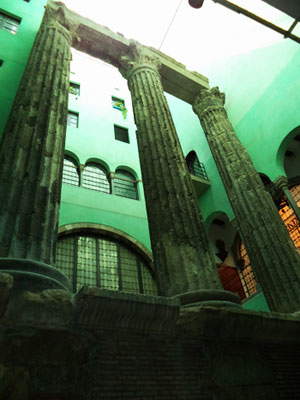A grand corner of ancient Rome in Barcelona: the Temple d'August
Wandering through the alleys of Barcelona’s Barri Gòtic, or the city’s oldest neighborhood, you may find yourself in front of a historic stone building with a large entrance. Intrigued, you will stop in front of an iron sign from the early twentieth century, from which hangs a sign, with characters from the same era, to read where you are: the building is in fact the headquarters of the Centre Excursionista de Catalunya and inside you can find the remains of the Roman Temple of Augustus (in Catalan: Temple romàd’ August or, more simply, Temple d’August), that is, what is the oldest remaining in the great Spanish city.
 |
| The Temple of Augustus in Barcelona. The fourth column is behind the first one from the left! |
All that remains of the temple, however, are four columns. It was one of the most important buildings in Roman Barcino: it was in fact a temple dedicated to the worship of the Emperor Augustus, because the Roman colony of Barcino had been founded precisely in the Augustan age, albeit on pre-existing sites. It was built at the end of the first century B.C., but there are also those who speculate that the construction dates to a later period, namely that of Emperor Tiberius, who formalized the cult of Augustus. The temple was located in the forum of the city(forum in Latin), the main square of every Roman city, where the buildings that regulated the administrative and religious life of the communities stood, and it was located at the intersection of the two main roads, the cardo maximus and the decumanus maximus: the former ran north-south and the latter east-west, and both connected the gateways to the city. The temple was the place where religious worship was celebrated, while the basilica, which was a place for business meetings and the administration of justice, and the curia, the seat of the municipal senate, had administrative functions.
Of the Temple of Augustus in Barcelona, as mentioned above, only four columns have been preserved (three arranged horizontally and the fourth located behind the first column) that reach the impressive height of nine meters. They are fluted, that is, they have their shafts traversed by grooves with decorative functions, called grooves. The columns have Corinthian order capitals (those with acanthus leaves), and part of thearchitrave, that is, the horizontal element immediately above the columns, and the podium, which is instead the base on which the columns rest, has also been preserved.
After the fall of theRoman Empire and following the spread of Christianity, the temple lost all its function, and during the Middle Ages it began to be dismembered as the material removed was reused in other constructions. Add to this the fact that the center of active life in early medieval Barcelona shifted further north, that is, to that area of the city where the first Christian nuclei had formed. Thus, towards the end of the 11th century, the appearance of the temple must not have been very different from what it looks like today, and later its remains were integrated into the medieval buildings that were being constructed in this part of the city: so much so that, even today, we admire the temple inside a medieval building. At the same time, the memory of these important vestiges of antiquity began to be lost: it was only in the nineteenth century, in fact, that it was unequivocally established that these were indeed remains of a Roman temple, and among the first to formulate the hypothesis that it was a temple dedicated to Augustus was the modernist architect Josep Puig i Cadafalch.
And also in the nineteenth century, a debate opened up about how to proceed with the monument’s recovery: move it to a freely accessible open space, or leave it inside the medieval building in which it was found? To speed things up, there came the Centre Excursionista de Catalunya, a body at once sporting and cultural (since its founding in 1876 it has also organized scientific excursions or aimed at studying cultural heritage), which purchased the building where the temple was located to make it its headquarters, which has remained so to this day. The Centre Excursionista commissioned the architect Lluís Domènech i Montaner to work on the building to restore it and to enhance the temple: it was he who, between 1903 and 1904, created the inner courtyard of the building surrounding the remains. Finally, in 1956, the fourth column, which at least since 1879 had been in the plaça del Rei where it had been placed following the discovery of its fragments, was moved to the temple site and then united with the other three. Today the temple is one of the sites managed by the MUHBA, the Museu d’Historia de Barcelona: admission is free and near the columns you will find several panels, in three languages (Catalan, Spanish and English), that will really give you a lot of information about the temple and the life of an ancient Roman city.
So if you find yourself wandering around near the Cathedral, specifically on carrer Paradís, when you get close to number 10, look around and look for the building that you think, inside, holds the monumental remains of a Roman temple. You will be surprised to find so much grandeur in a maze of narrow medieval alleys, and you will be amazed to be in one of the quietest corners of busy Barcelona!
Warning: the translation into English of the original Italian article was created using automatic tools. We undertake to review all articles, but we do not guarantee the total absence of inaccuracies in the translation due to the program. You can find the original by clicking on the ITA button. If you find any mistake,please contact us.




























